Annual Personal Recycling Event Returns
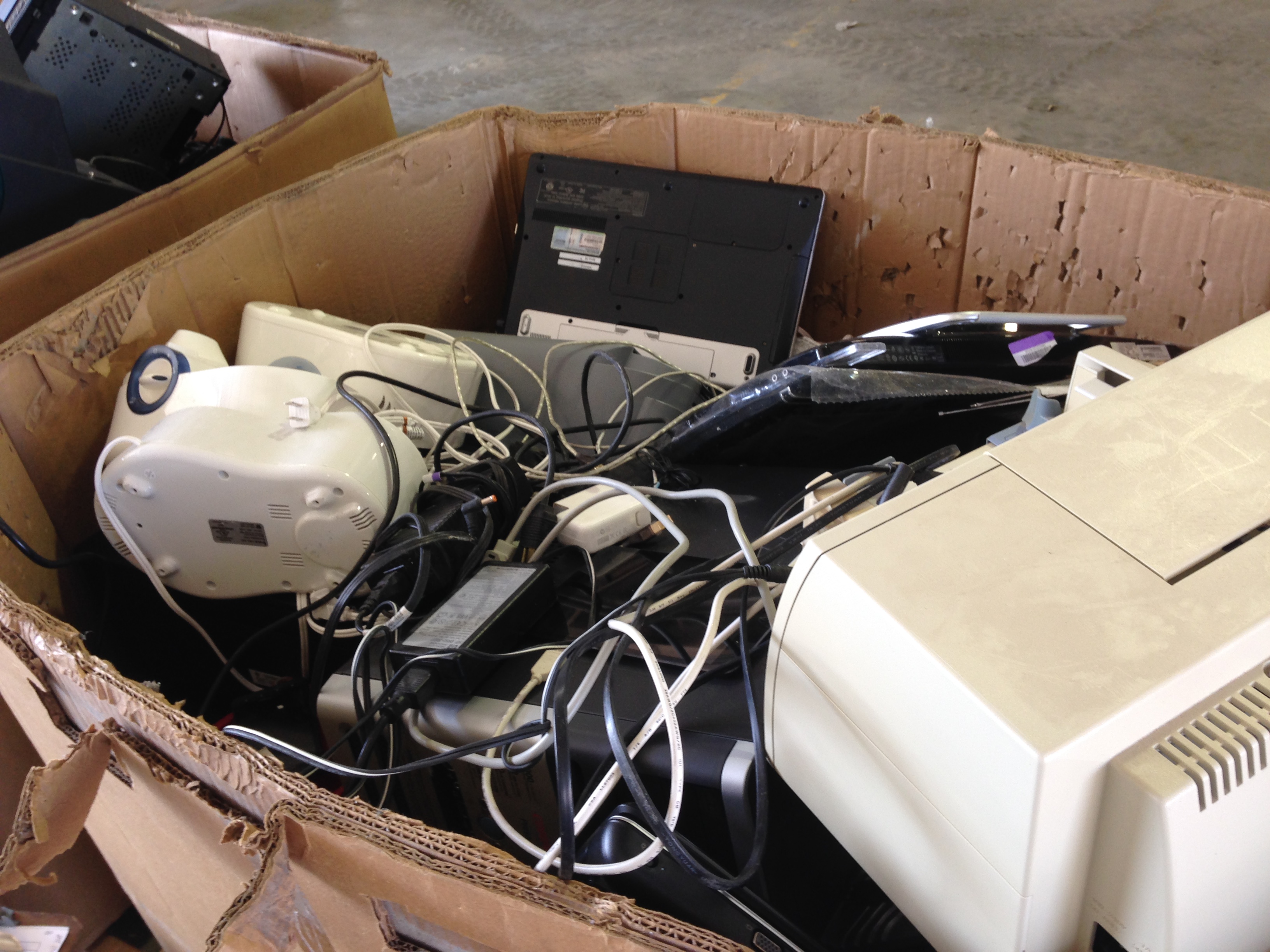
Spring is in the air (well, kind of, maybe?) and campus Earth Month activities are in full swing.
If you are starting spring-cleaning, we can help! We want to help you keep your personal information safe and responsibly dispose of items in your home, and I’m happy to report we can do that while recycling!
If you are a UNMC, Nebraska Medicine, UNO, or Clarkson College student/faculty/employee, please plan to attend our recycling event next week. The basic information is here, but please see our website for complete details.
Tuesday April 24th 10am-6pm, and Wednesday, April 25th 6am-2pm:
Have items at home you need to dispose of and can’t put in the trash? We will accept:
- Personal electronics to recycle; hard drives will be shredded. Most items will be free, but there will be a nominal cost for tube TVs, CRT monitors, and hard drives.
- Don’t forget that reuse is best! If your electronics work consider donating them. See the website for opportunities.
- Free personal document shredding.
- Free personal single use alkaline battery recycling.
- Free ‘techno trash’ (computer disks, CDs/DVD, VHS tapes) shredding & recycling
- Eyeglasses will be collected for donation to those in need.
- Have pop tabs for Ronald McDonald House? Bring those too!
UNMC/Nebraska Medicine Photo I.D. will be required to drop items off. We will be in a covered location and will hold event regardless of weather. For more details and a map of the drop-off location, please see our website. Really, I’m not kidding, click on the link; it will answer your questions and provide the details you need for drop-off.
If you can’t attend these events, there are a few other options:
- Several member groups have paper shredding events; check personal communications
- Keep Omaha Beautiful has several neighborhood clean-ups, you can attend any/all
- Electronics will be collected at Earth Day Omaha this Saturday
- Pop tabs can be directly taken to the Ronald McDonald house, 38th Ave/Jones St
- Eyeglasses can be taken directly to the Truhlsen Eye Institute
- If more opportunities arise, we’ll share them on our Facebook page: LiveGreenNebraska
If you are interested in other Earth Month events; on campus, at UNO, or Nebraska Science Festival events, please click here.
Drawdown EcoChallenge

If you aren’t a sustainability geek, it’s likely the release of Drawdown didn’t hit your radar. Drawdown was a landmark book that used immense amounts of data, (peer reviewed) research, models, and maps to determine the impact a variety of known solutions to global warming, centered around carbon reduction.
The authors predicted not only the global impact, but also the cost to implement as well as the economic savings, where applicable. It’s probably not surprising that #2 is wind turbines and #8 is solar farms but it may surprise you to know that management of refrigerants is ranked #1. Would it surprise you to know that #5 and #6 on the list are Education of Girls and Family Planning? Those stats caught a lot of attention, not only because they are an atypical response to climate change, but if you combine their impact, they easily become #1 on the list.
Lots of solutions made the list: LED bulbs, silvopasturing, mass transit, land management, methane digesters, etc. and most can be accomplished or influenced by everyone…no engineering or sustainability degree required. Some strategies are more applicable to specific areas of the world and/or can only be implemented in specific conditions, but all are capable of being implemented now…there’s no need to wait on future technology to be invented.
In the interest of starting to put these items into action, the Northwest Earth Institute has created the “Drawdown EcoChallenge”; a 21-day engagement program taking place between April 4-25, following the solutions highlighted in the book.
Ready to join our team?
You can sign up for free, track/share progress online and earn points. Points help us to compete against other groups while you have the chance to earn prizes. You can select as many actions as you want, ranging from replacing a bulb with a LED, to watching a video indigenous land management, using mass transit, or pledging to spend a specific amount of time learning about a topic. You can pick whatever piques your interest as there are over 80 actions to pick from in 7 different categories:
- Materials
- Food
- Transportation
- Land Management
- Women and Girls
- Electricity generation
- Buildings and Cities
So what are you waiting for? Join our team today to turn intention into action; all while having fun and winning prizes—oh, and having a positive impact on the planet and humanity.
TravelSmart Gains National Attention
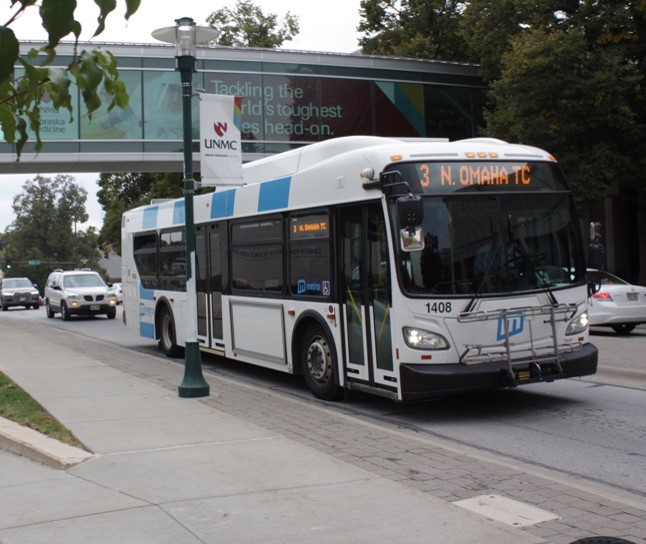
By Melanie Stewart
As you have hopefully heard, the active transportation goal in the Sustainability Master Plan was achieved early…six years early. Our success is largely due to the TravelSmart program.
TravelSmart is an inclusive program that not only encourages active transportation use, but also provides incentives/amenities for the user while removing common barriers. The jump in active transportation on this campus is impressive anywhere, but especially in a city that only has one form of public transportation and has minimal gridlock.
We’ve known this, but now others are noticing too.
This month TravelSmart was one of only 36 selected campuses featured in the APPA’s national publication Facilities Manager in their “Sustainability Best Practices” issue. You can read it here, on page 29.
Next month I will be presenting TravelSmart at Practice Greenhealth’s CleanMed conference, one of only two presentations selected to present on transportation.
Are you ready to be a TravelSmartie? Would you like to save money? Are you looking for ways to fit more exercise in your day? Would you like to reduce pollution and traffic congestion in Omaha?
Whether it’s walking, taking the bus, biking, carpooling or a combination of modes, active transportation helps keep you healthier AND makes our community healthier by cutting down on greenhouse gas emissions, which affects the health of the entire Metro, but especially those with asthma, COPD and other lung ailments.
Did you know? TravelSmart offers….
- FREE parking for carpoolers (in your same lot, or better!)
- FREE bus passes
- FREE indoor bike parking, shower, and locker access for cyclists and walkers
- FREE emergency ride home if needed
- FREE carpool matchingif you need help finding a carpool partner, and
- Convenient $3 daily-rate flexible parking.
Please note that you do NOT have to give up your current parking permit, nor do you need to use active transportation every day to participate in TravelSmart or see the financial benefits.
Did you know?
- Moms and dads with kids to drop-off and pick-up use TravelSmart
- Students and colleagues with inconsistent schedules use TravelSmart
- Business professionals use TravelSmart
… and so can YOU!
*We encourage any employee or student to use active transportation. However, please note that only employees and students at the 42nd and Dewey campus are currently eligible for TravelSmart.
If you are interested in active commuting but don’t think it will work for you, contact me. I will be happy to help you with trip planning.
Earth Day Events Announced
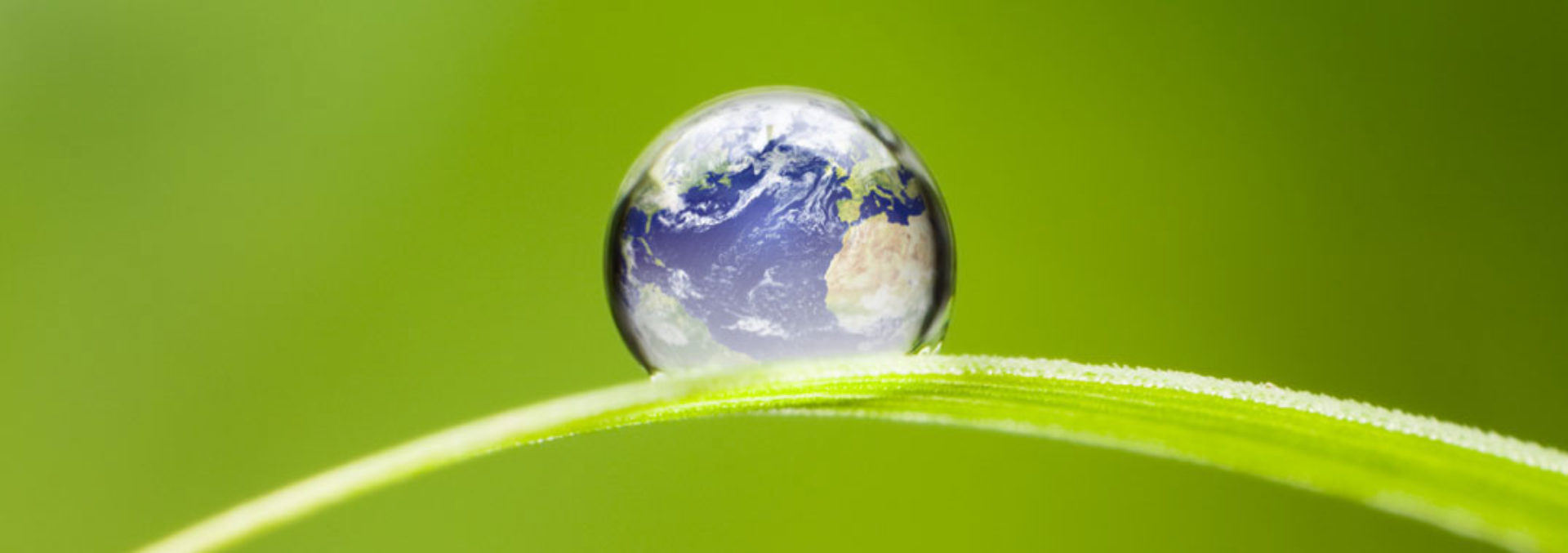
By Melanie Stewart
In the past we have always celebrated what we called “Earth Week”; events on campus for you to attend and gain personal knowledge and benefits, during the week between Earth Day and Arbor Day.
We have always asked for your feedback and last year many of you noted that it was difficult to attend events on back to back days. You also wanted to make sure that events stayed fresh, but that we continued to collect your personal electronics/batteries/techno trash for recycling and shredded your personal documents.
You asked and we listened!
We are going to spread events out throughout the month, now celebrating Earth Month, so it’s easier for you to make plans and attend.
We will still have the popular recycling/shredding event for your personal items. As before, we will host this on 2 days at different times to try and help fit a variety of schedules. Almost all items are free, but for costs and details (some of which have changed) please visit our website.
We will celebrate Arbor Day on the 27th with a tree planting, tree/wildflower seed giveaway, and will have Master Gardener Susan Siebler on hand to answer your questions.
We have two new events this year!
Free outdoor Yoga classes brought to you by the Center for Healthy Living.
UNO Sustainability Coordinator Sarah Burke will be sharing tried-and-true homemade recipes for cleaning/personal care items–reduce your exposure to chemicals and save money. This event will be offered 3 dates/locations for your convenience, click here for details.
The RePurpose It Contest is going to take a break, but will be back next year. Projects can be completed at any time, just take before and after pictures to share next spring and win prizes. For inspiration, check out previous year’s entries and/or our Pinterest page.
The Sustainability Expo is going to be co-hosted with UNO Sustainability. It’s free for your to attend every year, but each campus will host it on an every-other-year basis.
We are also going to highlight community events as well as sustainability-oriented Nebraska Scifest events that you and/or your family may be interested in attending. Please see our Earth Month webpage for dates, details, and links to specific information.
Hope to see you during Earth Month!
It’s PENdemonium
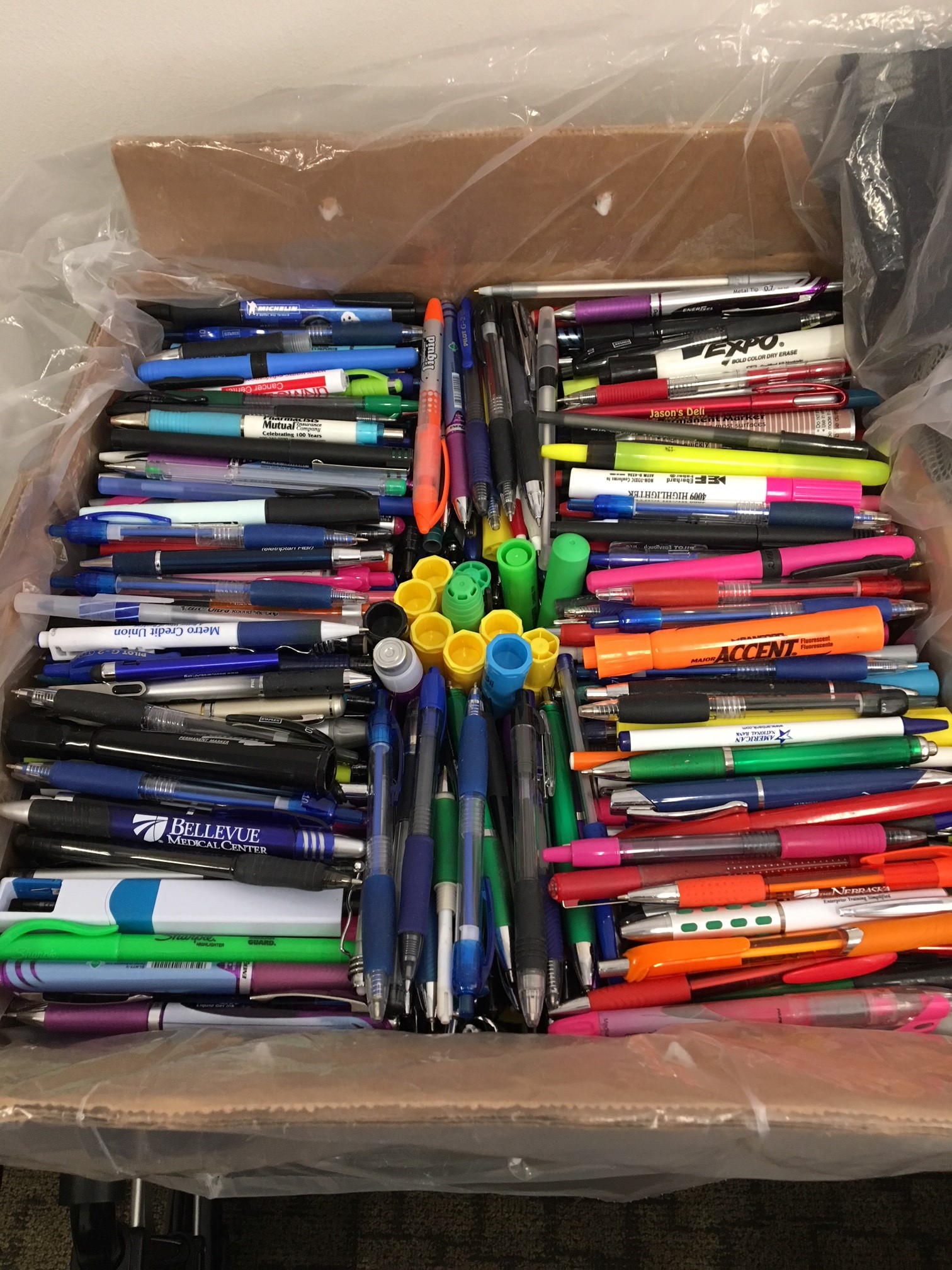
By Melanie Stewart
When your pen writes its last word or your highlighter goes dark, it’s easy to just toss it in the trash can. It’s so small and weighs next to nothing, so it doesn’t count for anything, right?
Nope.
By itself, it may not seem like much but when approximately 20,000 employees and students at all of our locations use some kind of writing utensil on a daily basis they start to add up. I am happy to prove this to you.
Instead of mailing in full boxes on their own, areas/departments that collect writing utensils now send them to the Office of Sustainability where they are packaged into specific box with a prepaid shipping label. We have to purchase this box as a way to offset recycling costs. To save money on boxes as well as use fewer resources in shipping we wanted to make sure we fit every pen into this box that we could. Rather than dumping pens in, creating a “pick-up-sticks” situation with lots of dead space we (and by “we” I mostly mean LiveGreen Ambassador Theresa Pikschus) devised a way to line them up.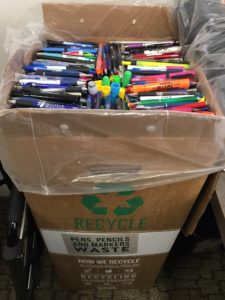
Last week we filled our first box of writing utensils to send in. We didn’t count the entire box, that’s too crazy even for me, but a quick calculation estimates that there were at least 6,000 pens in the box with a total weight of 102lbs. That’s a lot of pens that aren’t becoming litter or sitting in the landfill. If you need a visual, that’s a box that’s 15 inches square and 3 feet tall.
If you’ve been throwing your writing utensils away, don’t fret, you can start participating now. Check out our webpage for all the details you need to know.
As always, reduction and reuse are still best…and generally cheaper. Only buy writing utensils that people will actually use and in a quantity that will be used before they dry out. Consider pens that takes refills and mechanical pencils that just need lead instead of single-use versions.
Don’t ever feel like small actions taken by an individual don’t matter. Yes, big savings can be more flashy, but individuals making choices to make their lives and this planet better can really add up. Whether it’s a pen being recycled, the decision to stop sucking, or refilling a cup instead of buying a plastic bottle, it all helps.
New Sustainability Campus Engagement Goal

by Melanie Stewart
If you read last week’s 2017 Sustainability Master Plan Metric update, you noticed that we have made some progress on our Sustainability Engagement Score (SES), which is great news.
The SES is calculated using the answers to several questions in our biannual sustainability survey, the most recent of which was completed last fall. We gauge what colleagues and students know about sustainability, what sustainability actions they participate in, as well as those around them. This is then calculated into an overall engagement score, with the highest point total possible being 100. Here is the latest update:
CAMPUS ENGAGEMENT
- Baseline: Sustainability Engagement Score is 45 (out of a possible 100)
- Goal: Achieve a Sustainability Engagement Score of 75 by the end of 2023
- Progress: Current Sustainability Engagement Score is 59
We will need to have a high rate of engagement in order to meet our ambitious, updated, goals in emissions/energy, waste, water, and active transportation. In light of that need and in order to align the goal timeline with the other goals, a new goal has been approved:
Achieve a Sustainability Engagement Score of 85 by 2030.
A score of 85 is high making hitting that mark, especially by 2030, an ambitious goal as well. That said, I’m confident we can make it. I’ve spoken with so many of you who understand how important sustainability is and how it is connected directly to our mission of “creating a healthy future for all individuals and communities.”
If you want to be more involved, considering becoming a LiveGreen Ambassador. We don’t have regular meetings to worry about, and it’s a good way for you to get information, share it with colleagues, as well as provide feedback to the Office of Sustainability. If now isn’t a good time, the opportunity will always be available to you.
Thank you for all you do to help in reducing energy/emissions, conserving water, using active transportation, reducing/reusing/recycling, and all of the other “little” things you do that add up! Sometimes those actions seem small, but don’t discount them. Small acts done repeatedly create an impact on their own, and as more people do so, it will become the norm leading others to change their habits too. I look forward to attaining these goals with all of you as we move forward.
Sustainability Master Plan Metric Update
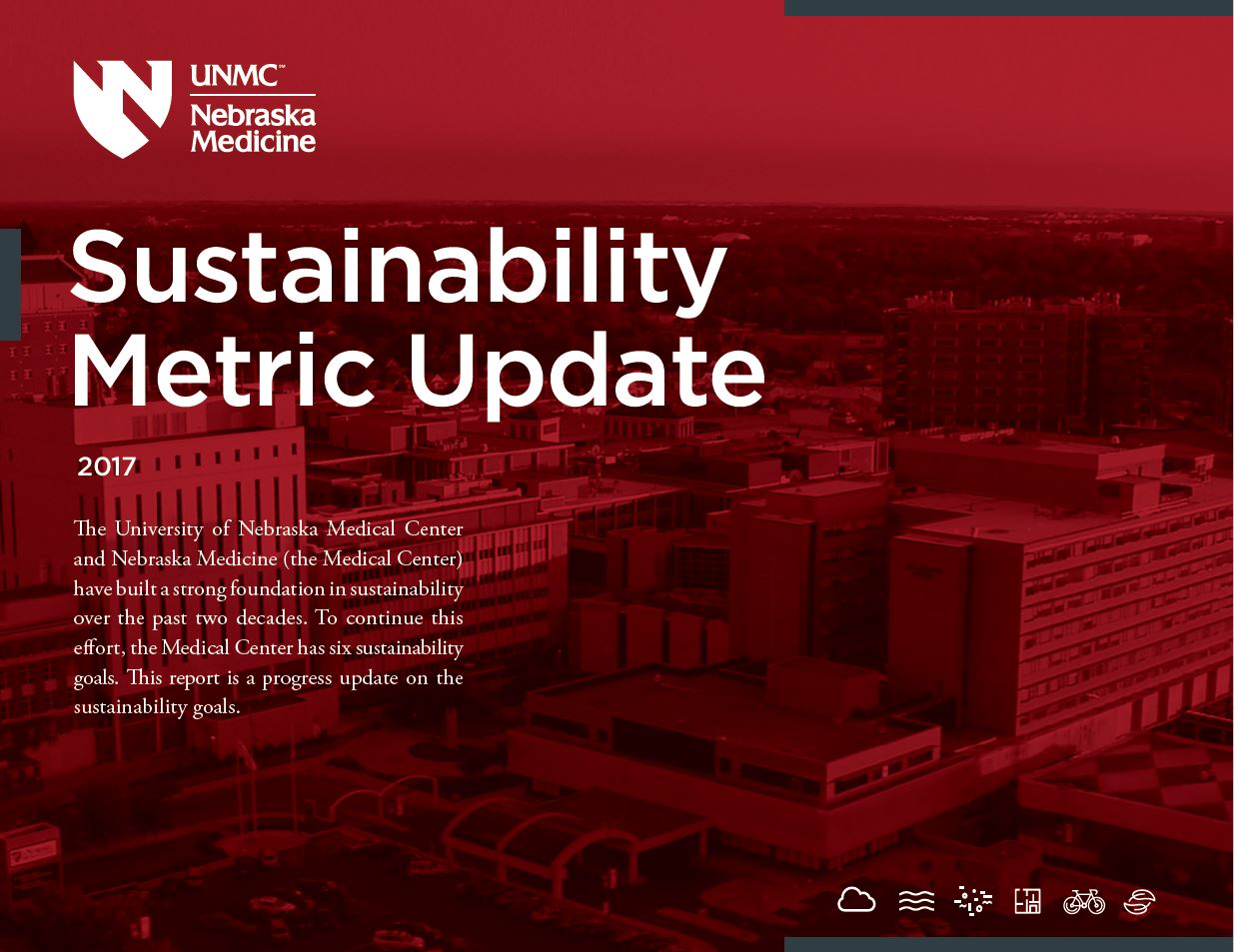
By Melanie Stewart
Attaining the TravelSmart goal early was a huge success; if you aren’t a TravelSmartie, I hope you will consider becoming one. Transportation is just one of the six goal areas in the Sustainability Master Plan, but all are important to our mission.
We are excited to release our 2017 Metric Update, an easy-to-read report containing a metric update, explanation, and specific initiatives contributing to those numbers. I hope you’ll take a look at it, but here’s a brief synopsis:
EMISSIONS
- Baseline: Produced 153,964 metric tons of carbon dioxide equivalent (CO2eq) each year.
- Goal: Achieve net zero building emissions by 2030.
- Progress: Produced 125,825 metric tons of CO2eq.
Efforts to reduce emissions have led to a cumulative reduction of 179,000 metric tons of carbon dioxide, equivalent to the annual emissions of 19,300 homes.
WATER
- Baseline: 225,164,787 gallons of water per year
- Goal: Reduce annual gallons of water used by 54% by 2030.
- Progress: Used 193,446,478 gallons.
Cumulative water reduction is 189,600,000 gallons, equivalent to 287 Olympic-sized swimming pools.
MATERIALS/WASTE
- Baseline: 25% of materials diverted from landfill.
- Goal: Zero Waste by 2030.
- Progress: 23% of materials diverted.
Waste reduction and recycling efforts have led to 2.1 million pounds of material not going to the landfill since 2012.
CAMPUS PLANNING
- Goal: Maintain current density of 73,326 gross square feet of built space per developed acre by 2023
- Progress: 55,513 square feet of built space per developed acre
TRANSPORTATION
- Baseline: 12% of employee/student commutes use active transportation mode (walk, bike, bus, or carpool)
- Goal: 20% of employee/student commutes use active transportation mode by 2023
- Progress: 22% of campus employees/student
- New Goal: 35% of commutes use active transportation by 2030
CAMPUS ENGAGEMENT
- Baseline: Sustainability Engagement Score is 45 (out of a possible 100)
- Goal: Achieve a Sustainability Engagement Score of 75 by the end of 2023
- Progress: Current Sustainability Engagement Score is 59
We will need to have a high rate of engagement in order to meet our ambitious, updated, goals. In light of that and in order to align the Engagement goal timeline with the other goals, a new goal has been approved:
Achieve a Sustainability Engagement Score of 85 by 2030.
Thank you for helping to reduce energy/emissions, conserve water, reduce/reuse/recycle, and all of the other little things you do that add up! If you want to be more involved, considering becoming a LiveGreen Ambassador.

Impressive Milestone Reached Ahead of Schedule

By Melanie Stewart
When the Sustainability Master Plan (SMP) was released, 12% of people on the 42nd Street campus used active transportation to commute. The SMP ambitiously set a goal to increase trips made to and from campus using active transportation to 20% by the year 2023.
Campus growth expedited the need as new buildings took the place of some parking spaces, and those buildings now bring even more colleagues to campus. Parking structures and lots are exceedingly expensive to build (did you know that it costs more than $25,000 per stall when building a parking garage?!?) and even more dollars to maintain, light, and snowplow. Building more parking was not proactive, cost-efficient, or in-line with the SMP goals, so the innovative TravelSmart program was born.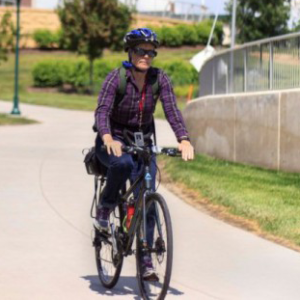
Since June of 2015 thousands of colleagues and students have registered to participate. They have ridden the bus, walked, biked, and carpooled to receive free parking, reduce emissions, be healthier, reduce stress, and save money.
I am excited to tell you that we have hit our 20% goal! Six years ahead of schedule 22% of trips to campus are being made by active transportation!
While those participating see immediate benefits, everyone else benefits too! By using active transportation, hundreds of cars don’t come to campus each day. That means less congestion on campus and on city streets, less road repair or need for expansion, and a lot less pollution. Decreasing pollution improves air quality in Omaha and benefits all of us, but especially those with asthma, COPD, and other lung ailments. Creating a healthy future for all individuals and communities is our mission.
Using only the data you provided in our sustainability survey last fall, we know that we have reduced single-occupant vehicle miles by more than 29,000 miles per week! That’s a lot…1.2 trips around the equator each week and 6.3 round trips to the moon each year; and all of the emissions associated with those miles.
That’s fantastic! Others might call it good and bask in this glory…but that’s not how we roll here. Improving health is our mission and we know that our campus will continue to grow. I’m excited to tell you that we have updated our goal and our timeline: 35% of trips to campus using active transportation by the year 2030. This goal is ambitious too, but worth it, and aligns with our other 2030 goals.
Considering TravelSmart? You don’t have to use active transportation every day or give up your parking permit (but you can to save money!). If you have any questions or need help with a bus route or finding a carpool partner, let us know.
Plan, Shop, and Chop to Reduce Food Waste
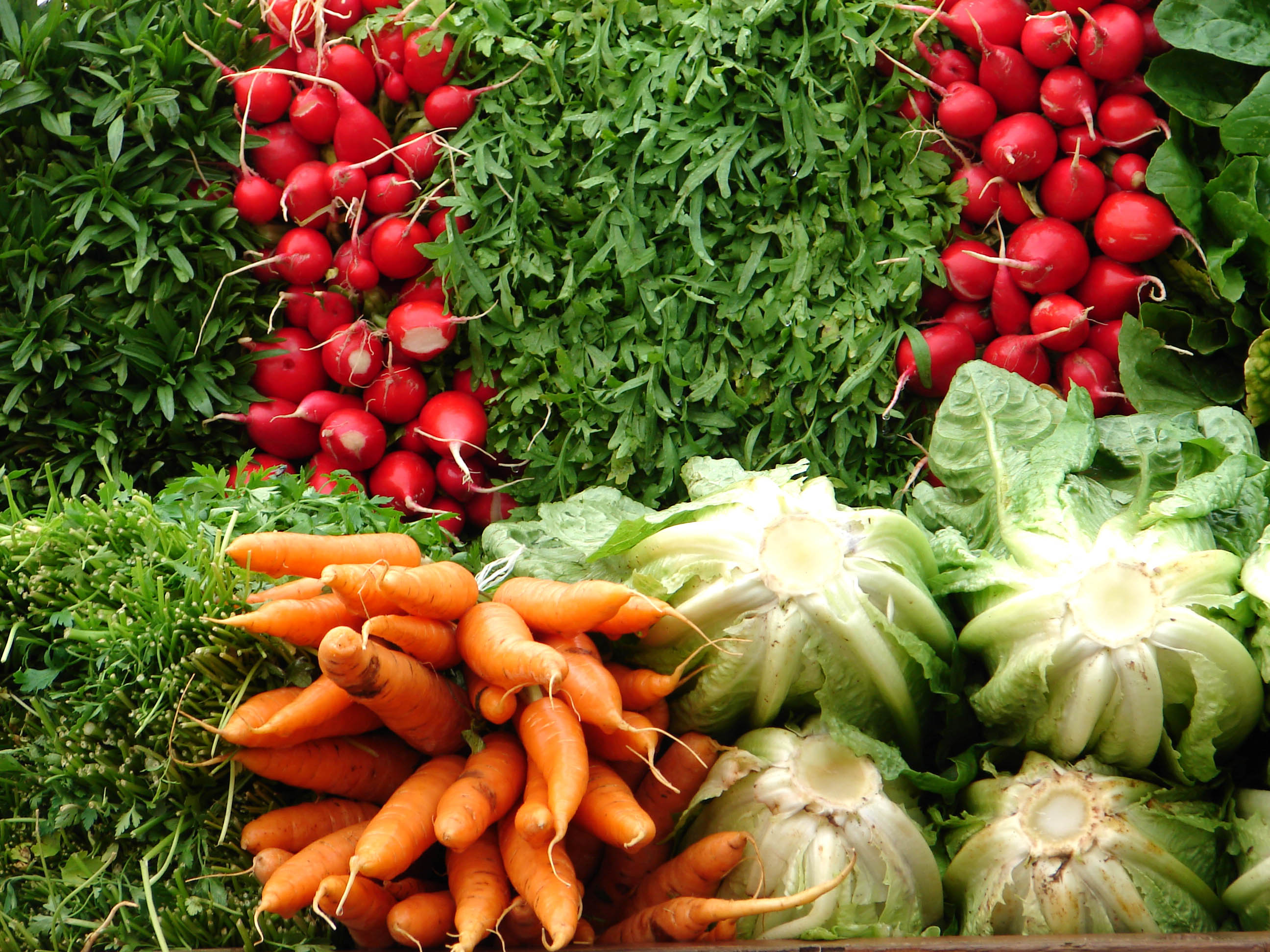
By Melanie Stewart
If you were one of the millions of people who made a resolution, there’s a decent chance it involved being healthier, and that often starts with eating more fruits and vegetables, and less pre-packaged foods.
In January we talked about the crazy amount of food that is wasted; the amount of money we spend on food we never eat, the resources that it took to produce that food, and amount of space in the landfill it takes up. We also provided resources on decipher dates on food packaging as well as food storage tips.
As noted, it’s easy to buy good food but then they go south once they are out of sight, out of mind. How can you prevent this, and save yourself some money? LiveGreen and the NRDC have some tips:
- Meal plan. Be honest about when you are going to cook, how many people you will be feeding, and what those people will actually eat.
- Make a list and stick to it. It’s shocking to me that only 25% of Americans go to the store with a list?! The good news: those that do spend less, make less impulse buys, and make fewer trips to the store. That’s a win-win-win!
- If you only need small quantities of certain items, only buy that quantity.
- Consider stores that have dry goods in bulk bins allowing you to measure out only what you need/can store.
- You can also use the salad bar to get a variety of (pre-chopped!) veggies for a specific recipe. It may cost a little more, but it’s cheaper than buying a dozen different vegetables and only eating half.
- Check the fine print; even if the sale says you get 5 for $5, you often don’t have to purchase that many to get the discounted price.
- Buy “Ugly Fruits and Vegetables.” The imperfections are cosmetic, the nutrition is the same, and if they aren’t purchased, the store trashes them.
- Try the “Shop and Chop”: when you come home for the store, items that need to be prepped don’t go into the fridge until they are washed and cut. Your strawberries are easy to grab and take to work with you in the morning…we both know it won’t happen when trying to wrangle everyone out the door.
These few easy tips can keep your healthy eating on the right track and keeping your pocketbook happy.
photo credit: freeimages.com/ramzihashisho
Clear the Air
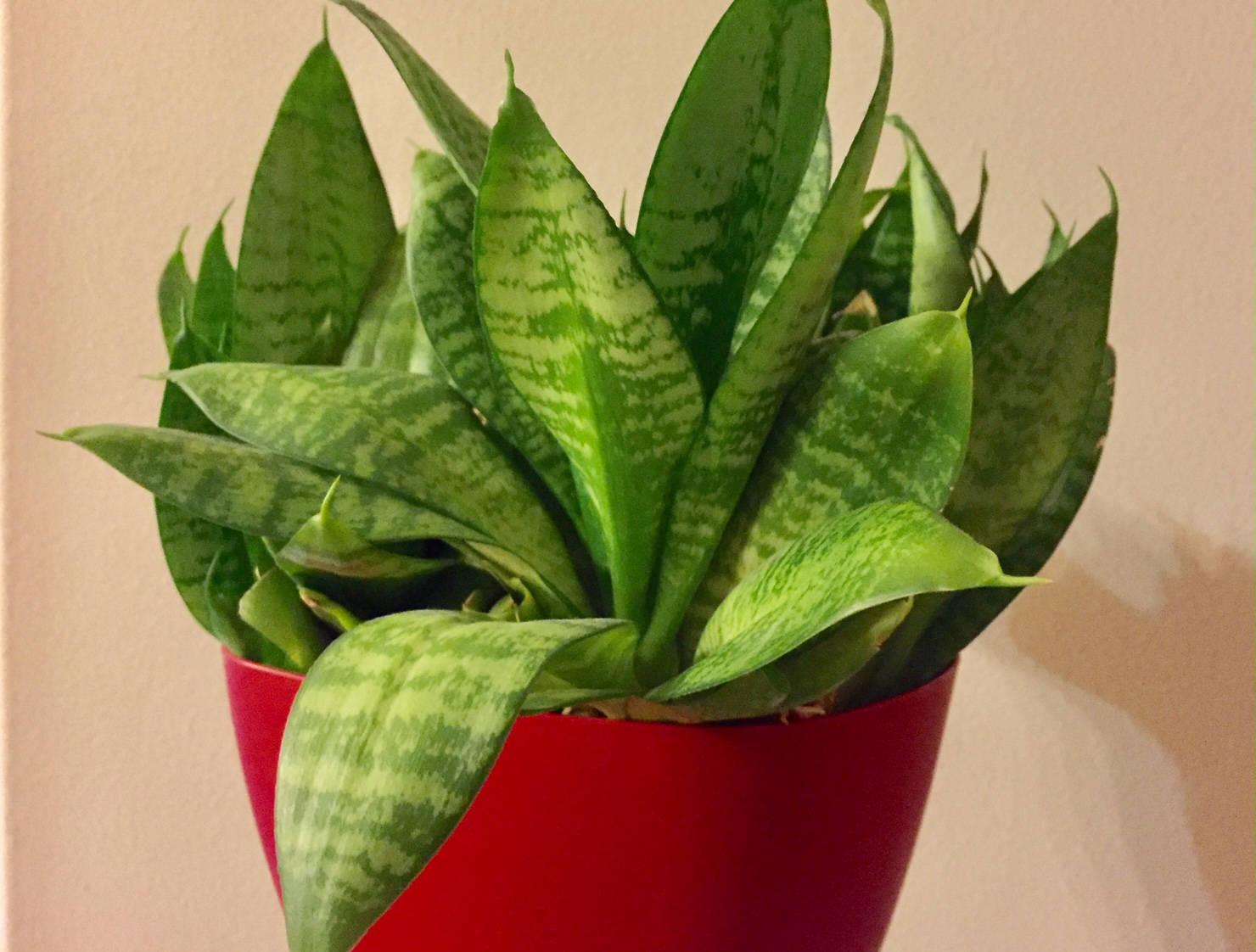
From work to school to home, we spend up to 90% of our time indoors. While it seems like this would protect you from the pollution outside, and that’s somewhat true, many of us don’t know that the air inside our homes is 2-5 more polluted than the air outside.
Formaldehyde. Benzene. Trichloroethylene. Toluene. Methylene chloride. They come from plywood and pressed-wood products, furniture, carpeting, cigarette smoke, new permanent-press clothing, paints, adhesives, and solvents. Even tightly closed paint cans leak VOCs (volatile organic compounds). These chemicals worsen asthma and other lung ailments and have been shown to cause cancer. They can build up in our homes and this is amplified during the winter months as doors and windows are kept closed.
Even our cleaning products can be hazardous. Products containing VOCs and other toxic substances can include:
- Aerosol spray products
- Air fresheners
- Chlorine Bleach (with heat it vaporizes to form chloroform, mixed with ammonia it forms chlorine gas)
- Detergents
- Dry cleaning chemicals
- Rug and upholstery cleaners
- Furniture and floor polish
- Oven cleaners
In warm weather we can open windows to ventilate, but what can we do in the winter?
New carpeting, furniture and pressed-wood products should be aired for 72 hours in a large, well-ventilated space before being installed, and permanent press clothing should be washed before it is worn.
Formaldehyde is used in some cosmetics, dish soaps, medicines, leather treatments and fabric softeners. Read the label before purchasing, look for certified-free products, and ventilate indoor spaces, particularly when using any product containing formaldehyde or other chemicals.
Check out the Environmental Working Group’s interactive guide for information on specific spaces, categories, and items. You can also check out LiveGreen’s cleaning page on Pinterest for natural cleaning recipes and tips.
Don’t forget the plants! Many houseplants are known to take in and store these harmful chemicals while releasing pure oxygen for you to breathe. Having plants around has been shown to lower blood pressure, reduce stress, add humidity, increase happiness, sharpen your focus and mental acuity, and help you recover from illnesses faster, just to name a few.
Here are some of the best houseplants that help clear the air of toxic chemicals:
- Peace Lily
- Warneck Dracaena
- Spider Plant
- Aloe
- Pothos
- Snake plant/Mother-in-Law’s Tongue
- ZZ plant
Most are easy to care for and survive in low-light and low-water (i.e. neglect) environments. For more information about air-cleaning houseplants, click here.
